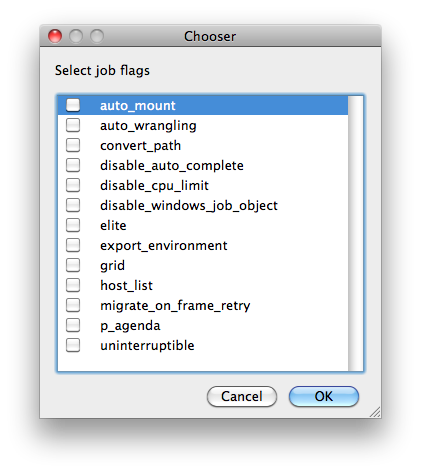-

-

- Created by John Burk, last modified by Joe Connellan on Oct 13, 2020
Step by step instructions for submitting After Effects jobs with Qube!
Install the Qube! Submission Menu
Install a submission menu into After Effects by opening the Wrangler View UI and choosing "Install AfterEffects AppUI..." as shown here.
After Effects job submission will be a little simpler and more flexible if Python is installed on the Workers (see Installing Python ). This allows Qube! to locate the After Effects executable automatically. However, installing Python is optional.

Configure the Submission Script
Once installed there are a few things that need to be done before using the script.
Run After Effects and open the General Preferences:
- Mac: After Effects > Preferences > General...
- PC: File > Preferences >General...
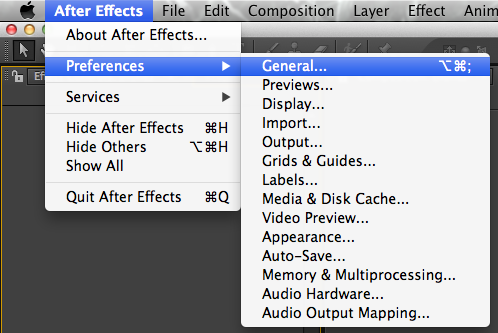
Tick "Allow Scripts to Write Files and Access Network"

With a scene loaded in After Effects, select "Add to Render Queue" from the "Composition" Menu.
Set up the Render Queue with the parameters and settings that you want for the project.
Save the scene file so that the render queue you just set up is available when the file is picked up on a Worker.


This is the Render Queue area
Now select "QubeAppFinder_Submit_RenderQueue.jsx" from the "File -> Scripts" menu.

If this is the first time you have done this, you will be presented with a dialog box that wants to know where to find the Wrangler View executable.
Fill this out appropriately:
- Mac: /Applications/pfx/qube/qube.app
- PC: C:\Program Files (x86)\pfx\qube\bin\qube.exe

This will present a pre filled submission UI.
Ensure sections marked in red have the correct details.
Useful Settings
IconWhile not strictly required, the following settings are useful for getting a better result. You will need to turn on "Expert Mode" (check box at the bottom of the submission UI) in order to get access to them.
- In "Execution" choose "Chunks with n frames". This is because loading the After Effects application and file typically takes much longer than the time to generate a frame, so it is more efficient to generate several from one After Effects session.
- Make sure the CS version (or Creative Cloud version, if used) is set to the correct version of After Effects.
- By default, Qube! will not retry failed frames. So set the "Retry frame/instance" value to 3 or 5, to get 3 or 5 retries before it gives up. Related to that, the default wait between retries is zero seconds, which is typically not useful. Set the "Retry Work Delay" to a value like 5 or 10 to allow machines time to recover from temporary problems such as network errors.

Click 'Submit'
For further details on the submission UI see below.

Job Submission Details
Not all sections need to be filled in in order to render only the fields marked in red are required

Name
This is the name of the job of the job so it can be easily identified in the Qube! UI.
Priority
Every job in Qube is assigned a numeric priority. Priority 1 is higher than priority 100. This is similar to 1st place, 2nd place, 3rd place, etc. The default priority assigned to a job is 9999.
Instances
This is the number of copies of the application that will run at the same time across the network. The combination of "Instances=1" and "Max Instances=-1" means that this job will take as much of the farm as it can, and all jobs will share evenly across the farm.
Examples:
On a 12 slot(core) machine running Maya if you set
"Instances" to 4
"Reservations" to "host.processors=3"
Qube! will open 4 sessions of Maya on the Worker(s) simultaneously, which may consume all slots/cores on a given Worker.
if you set
"Instances" to 1
"Reservations" to "host.processors=1+"
Qube will open 1 session of Maya on a Worker, consuming all slots/cores ("host.processors=1+" is used for all slots/cores).
Max Instances
If resources are available, Qube! will spawn more than 'Instances' copies of the application, but no more than 'Max Instances'. The default of -1 means there is no maximum. If this is set to 0, then it won't spawn more than 'Instances' copies.
More on Instances & Reservations & SmartShare Studio Defaults

Range
Frame range for the job (e.g 1-100, or 1-100x3, or 1,3,7,10)
Most jobs require a frame range to execute on the workers. You can set this range in a few different ways :
- "1-100" will just render the range between 1 and 100
- "1-100x3" will render the range 1 to 100, every third frame, so 1, 4, 7, etc.
- "1,3,7,10" will only render the selected frames 1,3,7,10
Execution
How to break up frame range to be executed. Use QB_START_FRAME, QB_END_FRAME and QB_FRAME_NUMBER
When submitting a job to the farm it may be more efficient to "chunk" your job. This means that when the job is sent to the worker it tells the worker to render N consecutive frames before requesting more work. You would do this to keep from reopening the scene file for each frame. Large scene files can take substantial time to open, which is wasteful across dozens or hundreds of frames.
The drop down options are below:
- "Individual frames" this tells the worker to render 1 frame at a time.
- "Chunks with n frames" this tells the worker to render consecutively the number of frames specified in the field.
- "Split into n partitions" this tells the worker to render consecutively the total frames in the range divided by the number in the field.
Examples:
- range 1-100 with "individual frames" set will render 1 frame at a time
- range 1-100 with "Chunks with n frames" and the field set to 5 will send 20 frames to each instance
- range 1-100 with "Split into n partitions" and the field set to 4 will send 25 frames to each instance
rangeOrdering
Order to render the items. (Ascending=1,2,3,4,5...,Descending=10,9,8...,Binary=first,middle,last...)
You can set the order in which your frames are rendered. The drop down options are:
- "Ascending" - this will render the frames counting upwards from your start frame
- "Decending" - this will render the frames counting backwards from your end frame
- "Binary" - This will render the first, last, and middle frames of the range, then the middle frame of the first half and the middle frame of the second half, and so on. This is useful for sampling the frames in the sequence to make sure it is rendering correctly.

Use Preview Frames
Enabling preview frames will create 2 jobs:
- A primary dependent job with a higher priority that will render the selected frames first
- A secondary job with lower priority that will render the remaining frames. This will return the selected frames faster so that you can check the accuracy of your renders.
Frame Numbers
Choose the frames that you wish to render first. If left blank the default is to render the first frame, the last frame and the middle frame in that order. You can select specific frames by adding comma separated frame numbers e.g 1,2,10,15,75, or a range with, e.g., 1-100x5 (1 to 100, every 5th frame)
Preview Priority
Choose the priority for the preview job. This can be set by the site admin.
Preview Subjobs
Choose the number of instances / subjobs for the preview frames. By default, this is equal to the number of preview frames - that is, it will try to do all the preview frames at the same time.
Note that when you submit a job with preview frames enabled, it will actually submit 2 jobs—one with the preview frames list at a higher priority, and another with the rest of the agenda, at the normal priority (as specified in the job's Priority field). You will get, consequently, 2 job IDs for the submission.
Parameters Specific to After Effects
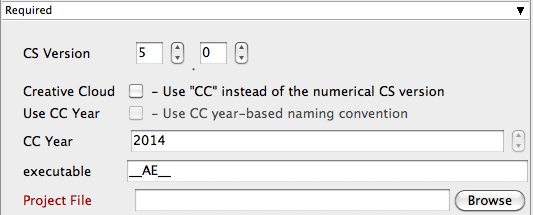
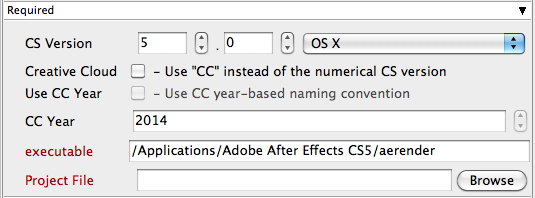
CS Version
Select version numbers to make an educated guess at where aerender is found on the remote worker. Use the spinners to enter the required version of After effects.
Creative Cloud
Check the box if you are using a Creative Cloud version of After Effects.
Use CC Year
Check the box if your Creative Cloud software is versioned by year, eg, Creative Cloud 2014.
CC Year
The year (version) of Creative Cloud After Effects to use. This only has meaning if the "Use CC Year" box is checked.
executable
Generally, this can be left alone. For AppFinder (top) version, this will tell Qube! to look for After Effects on the Worker. For the non-AppFinder (bottom) version, this is the explicit path to the executable. Note that in this case, it will be OS-dependent and won't work for jobs submitted between OS X and Windows.
Project File
Path to the After Effects project (required).
Note: After Effects requires that all plugins and fonts be installed and licensed on each Worker.
Important: Best practice is to ensure the project file and all of its dependent files such as textures are on network storage accessible by the workers.

Composition
If the comp is in the render queue already, and in a queueable state, then (only) the first queueable instance of that comp on the render queue will be rendered. If the comp is in the project but not in the render queue, then it will be added to the render queue and rendered. If no -comp argument is provided, aerender will render the entire render queue as is. In this case (no -comp), the only other arguments used will be -project, -log, -v, -mem_usage, and -close; the -RStemplate, -OMtemplate, -output, -s, -e, and -i arguments will be ignored.
Leave at the default unless you are an advanced After Effects user. For more information, see the After Effects documentation.
Render Queue Index
Specifies a render queue item to be rendered. Options that make sense when rendering a single render queue item are available like with the -comp flag. Enter the numeric value to override scene render queue index settings.
Leave at the default unless you are an advanced After Effects user. For more information, see the After Effects documentation.

Render Settings
Render Settings are normally set in the After Effects file itself, but can be overridden here. If the template does not exist it is an error. This can only be set if the Composition option is specified.
Output Module
Output Modules are normally set in the After Effects file itself, but can be overridden here. If the module does not exist it is an error. Note : Distributing a render across multiple machines requires image sequence output. That is usually best set in the AfterEffects Project or the Output File Path override.
Output File Path
Override the output file specified in the After Effects file. For image sequences (the preferred method for distributed rendering) use # to denote frames. For example: /Volumes/Stuff/output/proj1/frames[####].psd. Can only be set if the Composition option is specified.
Memory Usage
Takes two numerical values, separated by a space, that indicate maximum cache percentage and maximum memory percentage to use, respectively. The cache percentage is the maximum percent of memory used to cache already rendered images/footage, and the memory percentage specifies the total percent of memory that can be used by After Effects. These values override scene memory usage settings.

Verbosity
Choose the level of detail you would like the logs to provide.

Cmd Template
This is used to create the command string for launching the job on the worker. It will be set differently depending on the application you are launching from.
Shell (Linux/OSX)
Explicitly specify the Linux/OS X shell to use when executing the command (defaults to /bin/sh).
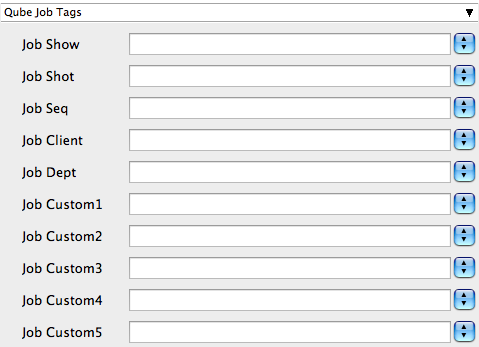
Qube Job Tags
New in Qube 6.5
Note: The Job Tags section of the submission UI will not be visible unless they are turned on in the Preferences in the Wrangler View UI. Job Tags are explained in detail on the Job Tags page.
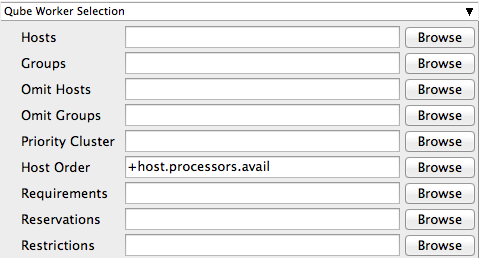
Hosts
Explicit list of Worker hostnames that will be allowed to run the job (comma-separated).
Groups
Explicit list of Worker groups that will be allowed to run the job (comma-separated). Groups identify machines through some attribute they have, eg, a GPU, an amount of memory, a license to run a particular application, etc. Jobs cannot migrate from one group to another. See worker_groups.
Omit Hosts
Explicit list of Worker hostnames that are not allowed run the job (comma-separated).
Omit Groups
Explicit list of Worker groups that are not allowed to run the job (comma-separated).
Priority Cluster
Clusters are non-overlapping sets of machines. Your job will run at the given priority in the given cluster. If that cluster is full, the job can run in a different cluster, but at lower priority. Clustering
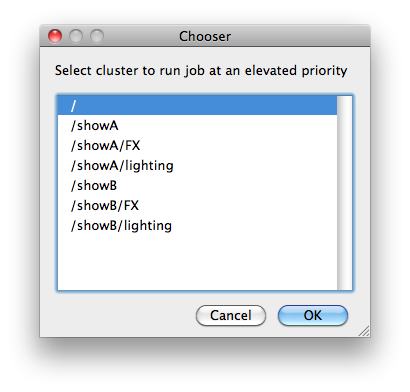 |
|---|
Example:
|
Host Order
Order to select Workers for running the job (comma-separated) [+ means ascending, - means descending].
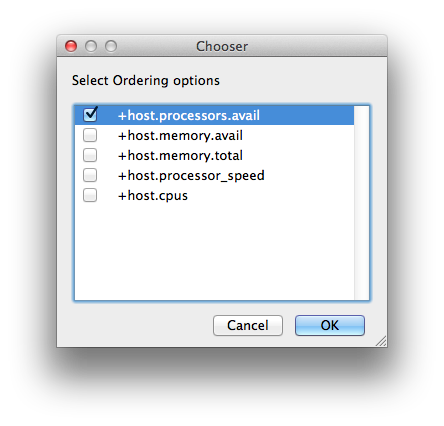 |
|---|
Host Order is a way of telling the job how to select/order workers
|
Requirements
Worker properties needed to be met for job to run on that Worker (comma-separated, expression-based). Click 'Browse' to choose from a list of Host Order Options.
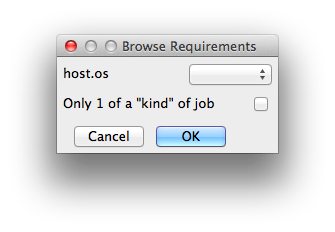 |
|---|
Requirements is a way to tell the workers that this job needs specific properties to be present in order to run. The drop-down menu allows a choice of OS:
You can also add any other Worker properties via plain text. Some examples:
With integer values, you can use any numerical relationships, e.g. =, <, >, <=, >=. This won't work for string values or floating point values. Multiple requirements can also be combined with AND and OR (the symbols && and || will also work). The 'Only 1 of a "kind" of job' checkbox will restrict a Worker to running only one instance with a matching "kind" field (see below). The prime example is After Effects, which will only allow a single instance of AE on a machine. Using this checkbox and the "Kind" field, you can restrict a Worker to only one running copy of After Effects, while still leaving the Worker's other slots available for other "kinds" of jobs. |
Reservations
Worker resources to reserve when running job (comma-separated, expression-based).
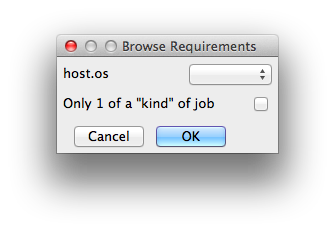 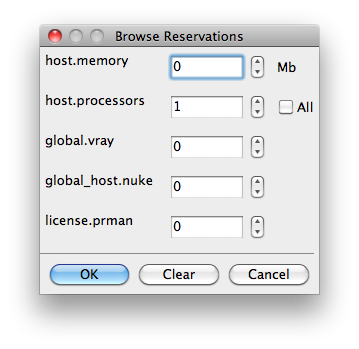 |
|---|
Reservations is a way to tell the workers that this job will reserve the specific resources for this job. Menu items:
Other options:
|
Restrictions
Restrict job to run only on specified clusters ("||"-separated) [+ means all below, * means at that level]. Click 'Browse' to choose from a list of Restrictions Options.
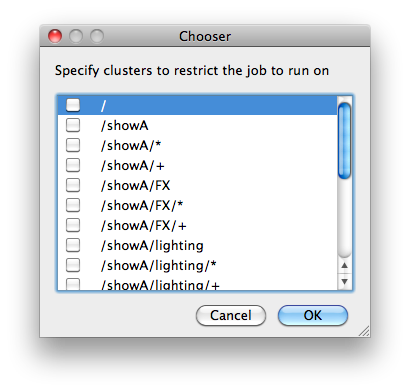 |
|---|
Restrictions is a way to tell the workers that this job can only run on specific clusters. You can choose more than one cluster in the list. Examples:
|
See Also
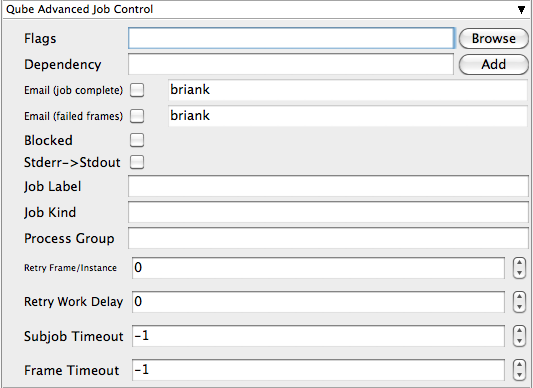
Flags
List of submission flag strings (comma separated). Click 'Browse' to choose required job flags.
|
|---|
| See this page for a full explanation of flag meanings |
Dependency
Wait for specified jobs to complete before starting this job (comma-separated). Click 'Add' to create dependent jobs.
 |
|---|
You can link jobs to each other in several ways:
The second menu chooses between "job" (the entire set of frames) and "work" (typically a frame). So to link frame 1 of one job to frame 1 of a second, job, you would choose "work" in this menu. If you want to wait for all the frames of one job to complete before starting a second, then choose "job". The other option, "subjob", refers to the instance of a job. This is much less common, but means that, for example, the instance of Maya that was running frames has completed. For a complete description on how to define complex dependencies between jobs or frames, please refer to the Callbacks section of the Developers Guide. |
Email (job complete)
Send email on job completion (success or failure). Sends mail to the designated user.
Email (failed frames)
Sends mail to the designated user if frames fail.
Blocked
Set initial state of job to "blocked".
Stderr->Stdout
Redirect and consolidate the job stderr stream to the stdout stream. Enable this if you would like to combine your logs into one stream.
Job Label
Optional label to identify the job. Must be unique within a Job Process Group. This is most useful for submitting sets of dependent jobs, where you don't know in advance the job IDs to depend on, but you do know the labels.
Job Kind
Arbitrary typing information that can be used to identify the job. It is commonly used to make sure only one of this "kind" of job runs on a worker at the same time by setting the job's requirements to include "not (job.kind in host.duty.kind)". See How to restrict a host to only one instance of a given kind of job, but still allow other jobs
Process Group
Job Process Group for logically organizing dependent jobs. Defaults to the jobid. Combination of "label" and "Process Group" must be unique for a job. See Process group labels
Retry Frame/Instance
Number of times to retry a failed frame/job instance. The default value of -1 means don't retry.
Retry Work Delay
Number of seconds between retries.
Subjob Timeout
Kill the subjob process if running for the specified time (in seconds). Value of -1 means disabled. Use this if the acceptable instance/subjob spawn time is known.
Frame Timeout
Kill the agenda/frame if running for the specified time (in seconds). Value of -1 means disabled. Use this if you know how long frames should take, so that you can automatically kill those running long.
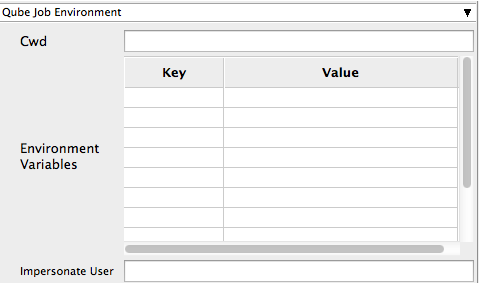
Cwd
Current Working Directory to use when running the job.
Environment Variables
Environment variables override when running a job. You can specify key/value pairs of environment variables
This is useful when you might need different settings for your render applications based on different departments or projects.
Impersonate User
You can specify which user you would like to submit the job as. The default is the current user. The format is simply <username>. This is useful for troubleshooting a job that may fail if sent from a specific user.
Example:
Setting "josh" would attempt to submit the job as the user "josh" regardless of your current user ID.
Note: In order to do this, the submitting user must have "impersonate user" permissions.
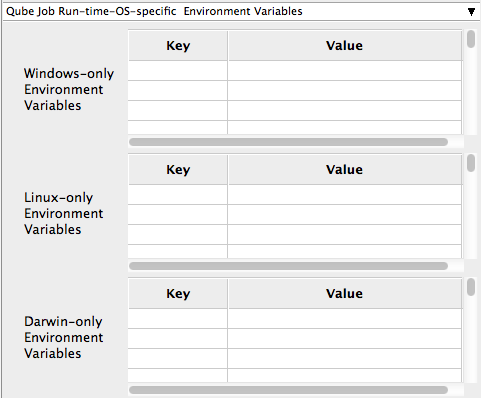
Windows-only Environment Variables
Used to provide OS specific environment variables for Windows. Enter variables and values to override when running jobs.
Linux-only Environment Variables
Used to provide OS specific environment variables for Linux. Enter variables and values to override when running jobs.
Darwin-only Environment Variables
Used to provide OS specific environment variables for OS X. Enter variables and values to override when running jobs.
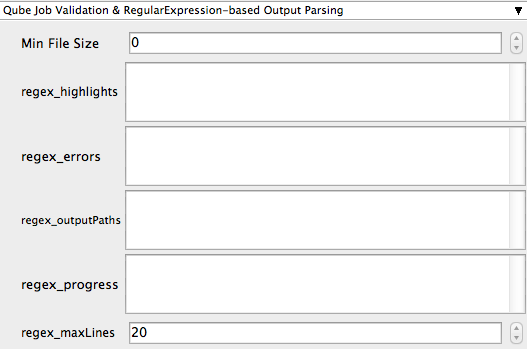
Min File Size
Used to test the created output file to ensure that it is at least the minimum size specified. Put in the minimum size for output files, in bytes. A zero (0) disables the test.
regex_highlights
Used to add highlights into logs. Enter a regular expression that, if matched, will be highlighted in the information messages from stdout/stderr.
regex_errors
Used to catch errors that show up in stdout/stderr. For example, if you list "error: 2145" here and this string is present in the logs, the job will be marked as failed. This field comes pre-populated with expressions based on the application you are submitting from. You can add more to the list, one entry per line.
regex_outputPaths
Regular expression for identifying outputPaths of images from stdout/stder. This is useful for returning information to the Qube GUI so that the "Browse Ouput" right-mouse menu works.
regex_progress
Regular expression for identifying in-frame/chunk progress from stdout/stderr. Used to identify strings for relaying the progress of frames.
regex_maxlines
Maximum number of lines to store for regex matched patterns for stdout/stderr. Used to truncate the size of log files.
Examples
IconTo see examples of regular expressions for these contexts, look at the Nuke (cmdline) submission dialog - it has several already filled in.

GenerateMovie
Select this option to create a secondary job that will wait for the render to complete then combine the output files into a movie.
Note: For this to work correctly the "Qube (ImagesToMovie) Job..." has to be setup to use your studios transcoding application.

Account
Arbitrary accounting or project data (user-specified). This can be used for creating tags for your job.
You can add entries by typing in the drop-down window or select already created accounts from the drop-down.
See also Qube! Job Tags
Notes
Freeform text for making notes on this job. Add text about the job for future reference. Viewable in the Qube UI.
- No labels
- Powered by Scroll Content Management Add-ons for Atlassian Confluence 5.6.6 | 2.8.10
- Powered by Scroll Content Management Add-ons for Atlassian Confluence.
